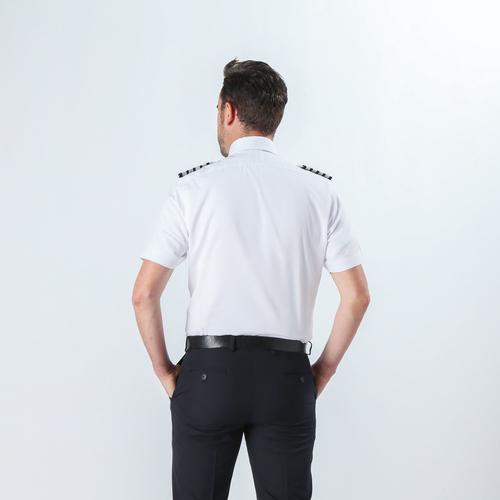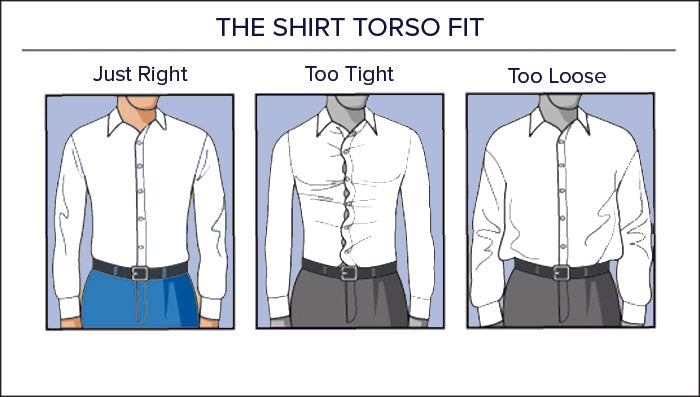
How to Select the Perfect Pilot Shirt Fit:
In the airline industry, we have long had to make do with one size fits all pilot shirts that fit perfectly on the collar, but are too baggy in all other areas. Most pilot shirt manufacturers keep their costs down by producing one fit which accommodates all body shapes. Unfortunately, this has created a culture of aircrew walking around in baggy uniforms that don’t reflect the professionalism with which they approach their flying.
What’s more, culture is changing. Office workers now select shirts that are increasingly fitted, with people wanting to show off their hard earned results from time in the gym. At Airman, we have been working with London shirtmaker T.M.Lewin (www.tmlewin.com) to ensure that these latest size trends are reflected in the way we make our pilot shirts. Below is a guide with what you should look for when selecting the perfect fit.
Collars:
A well fitted collar should frame your face whilst being comfortable.
Too Tight: Collars dig into the neck so that skin folds on top of the collar. The collar feels very uncomfortable on the neck.
Too Loose: Most of the collar doesn’t actually touch the neck, often causing the fabric to crumple and droop.
Just right: A perfect fit means that the collar follows the neck all the way round, but the wearer should be able to insert two fingertips between the fabric and the skin.

Shoulders:
Shoulder fit is measured in relation to the furthest lateral extent of the shoulder bone.
Too Tight: The stitch between the torso and the sleeve of the shirt sits inward of the point of the shoulder bones. This restricts the wearers movement and causes wrinkling.
Too Loose: The stitch sits outside of the shoulder bone, on the upper arm. This makes the pilot shirt appear ill fitting.
Just right: The stitch sits perfectly on the edge of your shoulders, allowing arms to move freely.

Torso:
For pilots who transition between standing and seated positions, a balanced torso fit is key.
Too Tight: The placket (where the buttons and buttonholes meet) is stretched away from the buttons, and extra pressure is felt along the shoulders. This is more evident in a seated position.
Too Loose: Excess bunches of fabric collect around the waist and create a ‘muffin top’ effect over the belt.
Just Right: The shirt fabric rests lightly against the wearer’s ribcage yet buttons are easy to close.

Sleeves:
Pilot shirts should fitted to the wearers arm, whilst providing sufficient freedom of movement in order to reach overhead panels without discomfort.
Too Tight: With long sleeve shirts there will be a pinching feeling in the elbow or the shoulder. In the customary short sleeve pilot shirt, sleeves feel uncomfortable around the bicep and wrinkle easily.
Too Loose: In long sleeve shirts, extra folds of fabric exist down the arm, predominantly at the cuff. Short sleeve shirts tend to billow outwards, with the seam in the fabric extending from the wearers arm.
Just Right: In long sleeve shirts, there should be some freedom of movement (3 cm) when the arm hangs straight. Short sleeve shirts should follow the wearers arm, but the seam should remain intact.

Sleeve Length:
Long sleeve pilot shirts are not the norm, but can look more professional and can be more insulating in winter.
Too short: Cuffs leave wrist bones exposed, or disappear entirely within the pilot jacket.
Too Long: Sleeves extend all the way past the wrist to the hand, covering the watch and causing bunching.
Just Right: The sleeve should touch wrist bones on the pinky finger side of your hand. Your watch should be in contact with the cuff, but remain exposed.

All in all, if all these bases are covered, you should have a shirt that fits perfectly. At Airman, we have a number of styles to choose from, including Slim Fit and Fitted Pilot Shirts. To make sure you are buying the right shirt, consult our size guide.
